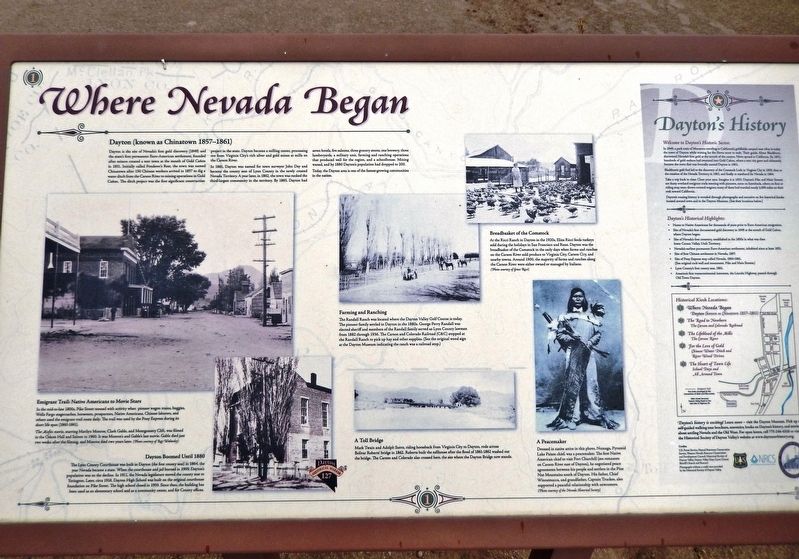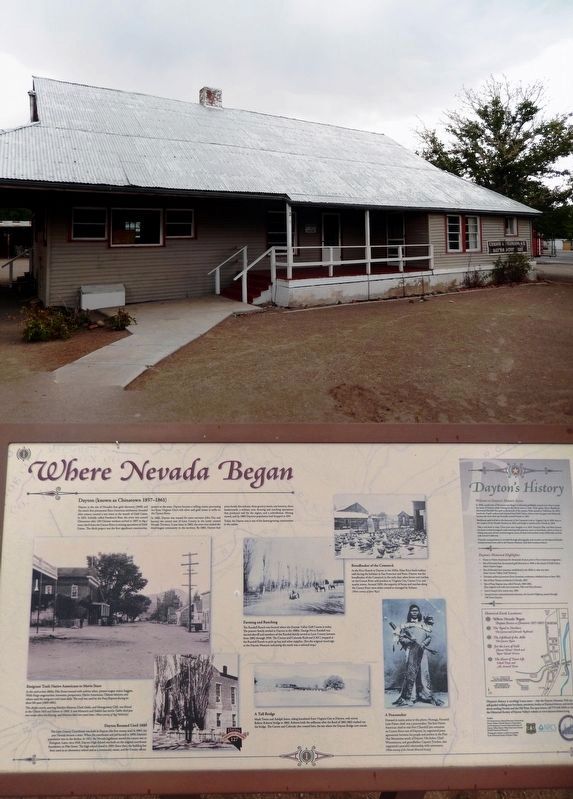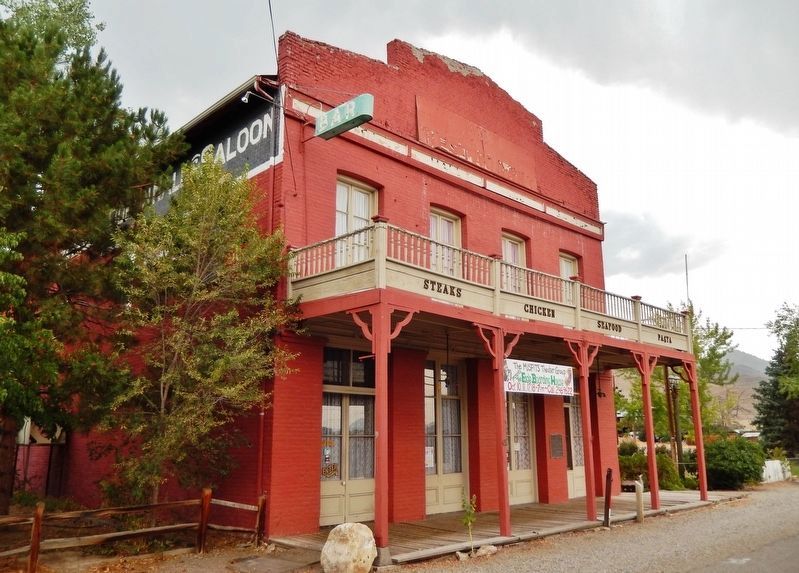Dayton in Lyon County, Nevada — The American Mountains (Southwest)
Where Nevada Began
Dayton's History
Dayton (known as Chinatown 1857-1861)
Dayton is the site of Nevada's first gold discovery (1849) and the state's first permanent Euro-American settlement, founded after miners created a tent town at the mouth of Gold Cañon in 1851. Initially called Ponderer's Rest, the town was named Chinatown after 150 Chinese workers arrived in 1857 to dig a water ditch from the Carson River to mining operations in Gold Cañon. The ditch project was the first significant construction project in the state. Dayton became a milling center, processing ore from Virginia City's rich silver and gold mines at mills on the Carson River.
In 1861, Dayton was named for town surveyor John Day and became the county seat of Lyon County in the newly created Nevada Territory. A year later, in 1862, the town was ranked the third-largest community in the territory. By 1865, Dayton had seven hotels, five saloons, three grocery stores, one brewery, three lumberyards, a military unit, farming and ranching operations that produced well for the region, and a schoolhouse. Mining waned, and by 1880 Dayton's population had dropped to 200.
Today, the Dayton area is one of the fastest-growing communities in the nation.
[sidebar] Dayton's History
Welcome to Dayton's Historic Sector.
In 1849, a pack train of Mormons traveling to California's goldfields camped near what is today the town of Dayton while waiting for the Sierra snow to melt. Their guide, Abner Blackburn, discovered Nevada's first gold at the mouth of the canyon. News spread to California. By 1851, hundreds of gold-seekers had swarmed into Gold Canon, where a tent city grew and ultimately became the town that was formally named Dayton in 1861.
Blackburn's gold find led to the discovery of the Comstock Lode in Virginia City in 1859, then to the creation of the Nevada Territory in 1861, and finally to statehood for Nevada in 1864.
Take a trip back in time: Close your eyes. Imagine it is 1853. Dayton's Pike and Main Streets are dusty overland emigrant trails teeming with pioneers, some on horseback, others on foot or riding atop oxen-drawn covered wagons; many of them had traveled nearly 2,000 miles on their trek toward California.
Dayton's rousing history is revealed through photographs and narrative on five historical kiosks located around town and in the Dayton Museum. (See their locations below.)
Dayton’s Historical Highlights:
• Home to Native Americans for thousands of years prior to Euro-American emigration.
• Site of Nevada's first documented gold discovery in 1849 at the mouth of Gold Cañon, where Dayton began.
• Site of Nevada's first cemetery, established in the 1850s in what
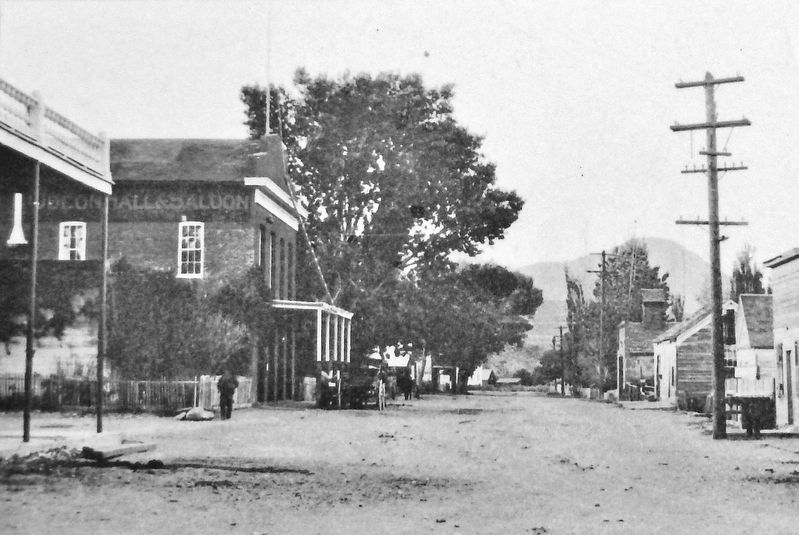
Courtesy Ray Walmsley
2. Marker detail: Native Americans to Movie Stars
In the mid-to-late 1800s, Pike Street teemed with activity when pioneer wagon trains, buggies, Wells Fargo stagecoaches, horsemen, prospectors, Native Americans, Chinese laborers, and others used the emigrant trail route daily. The trail was used by the Pony Express during its short life span (1860-1861).
The Misfits movie, starring Marilyn Monroe, Clark Gable, and Montgomery Clift, was filmed in the Odeon Hall and Saloon in 1960. It was Monroe’s and Gable’s last movie. Gable died just two weeks after the filming, and Monroe died two years later.
The Misfits movie, starring Marilyn Monroe, Clark Gable, and Montgomery Clift, was filmed in the Odeon Hall and Saloon in 1960. It was Monroe’s and Gable’s last movie. Gable died just two weeks after the filming, and Monroe died two years later.
• Nevada's earliest permanent Euro-American settlement, inhabited since at least 1851.
• Site of first Chinese settlement in Nevada, 1857.
• Site of Pony Express stop called Nevada, 1860-1861.
(See original rock wall and monument, Pike and Main Streets.)
• Lyon County's first county seat, 1861.
• America's first transcontinental interstate, the Lincoln Highway, passed through Old Town Dayton.
Erected by U.S. Forest Service, Natural Resources Conservation Service, and Historical Society of Dayton Valley. (Marker Number 1.)
Topics and series. This historical marker is listed in these topic lists: Agriculture • Arts, Letters, Music • Industry & Commerce • Settlements & Settlers. In addition, it is included in the Lincoln Highway series list. A significant historical year for this entry is 1849.
Location. 39° 14.185′ N, 119° 35.402′ W. Marker is in Dayton, Nevada, in Lyon County. Marker is on Main Street just west of Lincoln Highway (U.S. 50), on the right when traveling west. Marker overlooks the southwest corner of the Carson & Colorado Depot building. Touch for map. Marker is at or near this postal address: 58 Main Street, Dayton NV 89403, United States of America. Touch for directions.
Other nearby markers. At least 8 other markers are within walking distance of this marker. The Road to Nowhere (here, next to this marker); Carson & Colorado Railroad
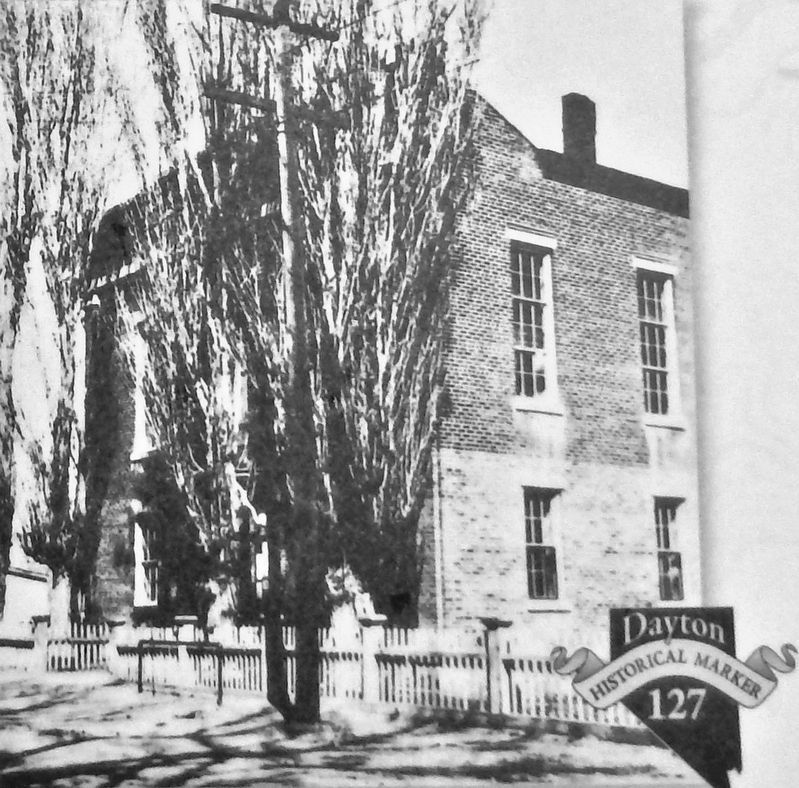
Courtesy Historical Society of Dayton Valley
3. Marker detail: Dayton Boomed Until 1880
(Courthouse Site 1864 – 1909)
The Lyon County Courthouse was built in Dayton (the first county seat) in 1864, the year Nevada became a state. When the courthouse and jail burned in 1909, Dayton's population was on the decline. In 1911, the Nevada legislature moved the county seat to Yerington. Later, circa 1918, Dayton High School was built on the original courthouse foundation on Pike Street. The high school closed in 1959. Since then, the building has been used as an elementary school and as a community center, and for County offices.
Related markers. Click here for a list of markers that are related to this marker. Dayton's History
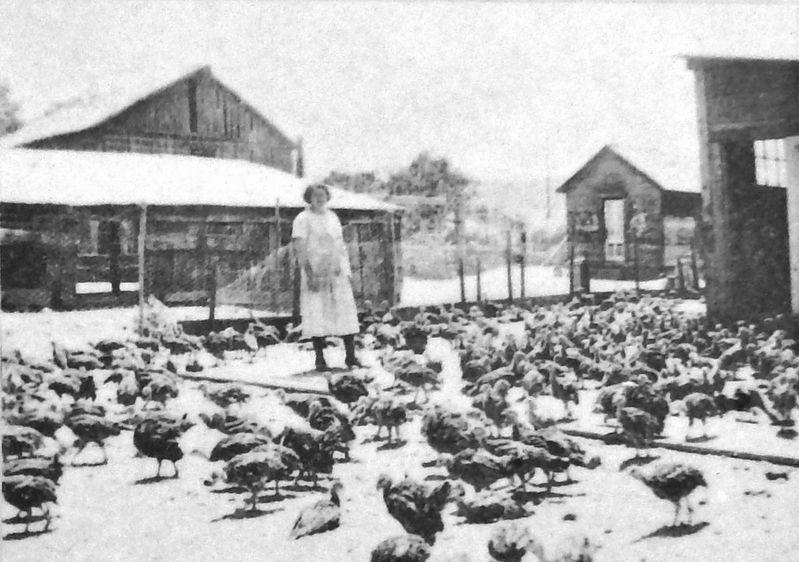
Courtesy Grace Ricci
4. Marker detail: Breadbasket of the Comstock
At the Ricci Ranch in Dayton in the 1920s, Eliza Ricci feeds turkeys sold during the holidays in San Francisco and Reno. Dayton was the breadbasket of the Comstock in the early days when farms and ranches on the Carson River sold produce to Virginia City, Carson City, and nearby towns. Around 1900, the majority of farms and ranches along the Carson River were either owned or managed by Italians.
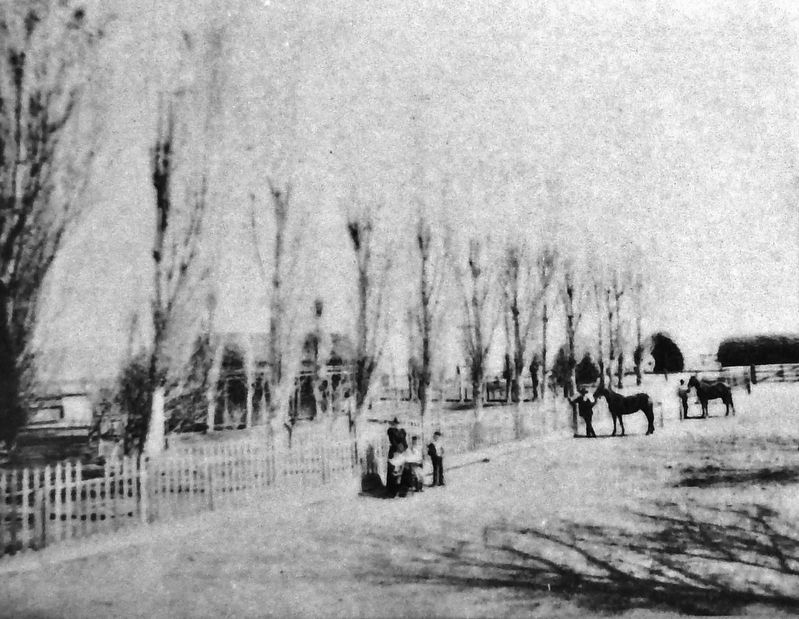
Courtesy Historical Society of Dayton Valley
5. Marker detail: Farming and Ranching
The Randall Ranch was located where the Dayton Valley Golf Course is today. The pioneer family settled in Dayton in the 1880s. George Perry Randall was elected sheriff and members of the Randall family served as Lyon County lawmen from 1882 through 1936. The Carson and Colorado Railroad (C&C) stopped at the Randall Ranch to pick up hay and other supplies. (See the original wood sign at the Dayton Museum indicating the ranch was a railroad stop.)
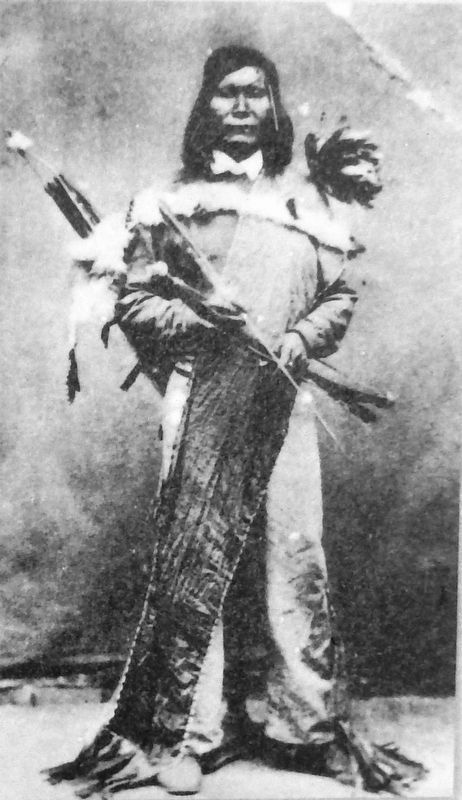
Courtesy Nevada Historical Society
6. Marker detail: A Peacemaker
Dressed in native attire in this photo, Numaga, Pyramid Lake Paiute chief, was a peacemaker. The first Native American chief to visit Fort Churchill (see remnants on Carson River east of Dayton), he negotiated peace agreements between his people and settlers in the Pine Nut Mountains south of Dayton. His father, Chief Winnemucca, and grandfather, Captain Truckee, also supported a peaceful relationship with newcomers.
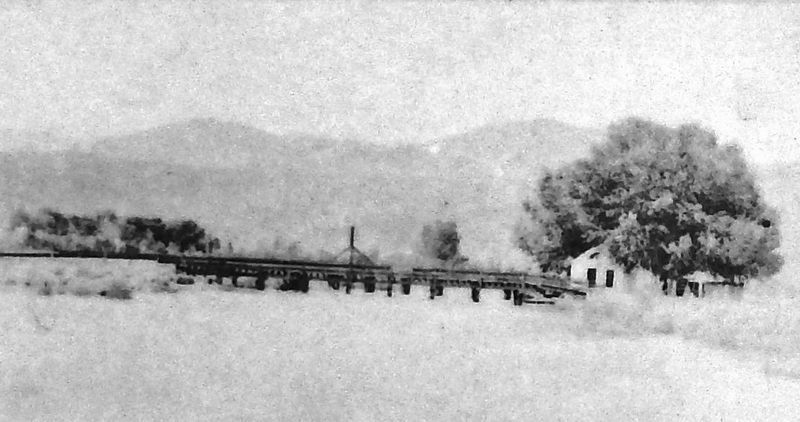
Courtesy Historical Society of Dayton Valley
7. Marker detail: A Toll Bridge
Mark Twain and Adolph Sutro, riding horseback from Virginia City to Dayton, rode across Bolivar Roberts' bridge in 1862. Roberts built the tollhouse after the flood of 1861-1862 washed out the bridge. The Carson and Colorado also crossed here, the site where the Dayton Bridge now stands.
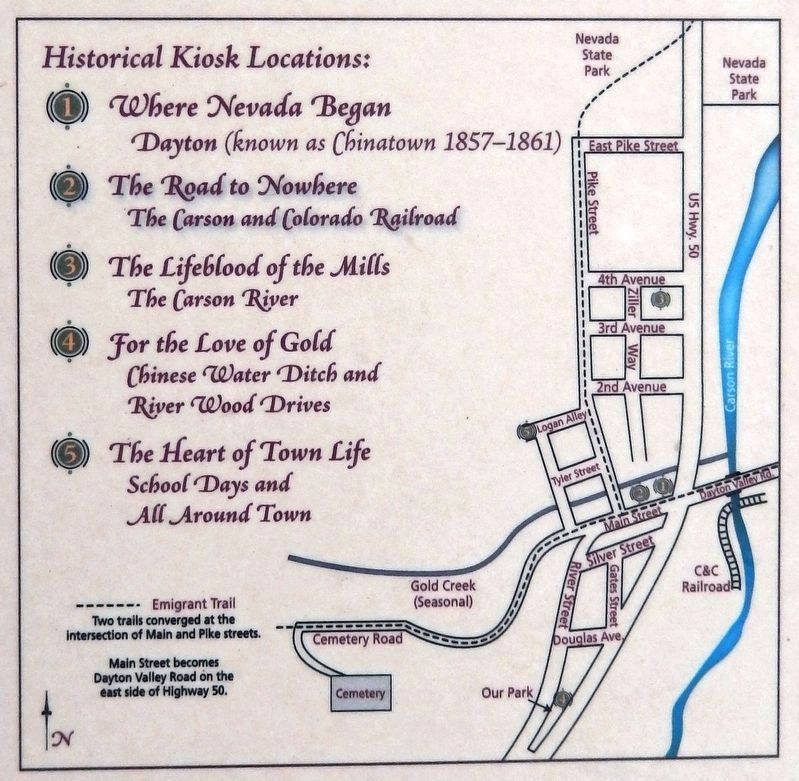
8. Marker detail: Historical Kiosk Locations
Dayton's history is exciting! Learn more — visit the Dayton Museum. Pick up a self-guided walking tour brochure, souvenirs, books on Dayton's history, and stories about settling Nevada and the Old West. For open hours, call 775-246-6316 or visit the Historical Society of Dayton Valley's website at www.daytonnvhistory.org.
Credits. This page was last revised on November 27, 2020. It was originally submitted on November 24, 2020, by Cosmos Mariner of Cape Canaveral, Florida. This page has been viewed 383 times since then and 56 times this year. Photos: 1, 2, 3, 4, 5, 6, 7, 8, 9, 10. submitted on November 27, 2020, by Cosmos Mariner of Cape Canaveral, Florida.
